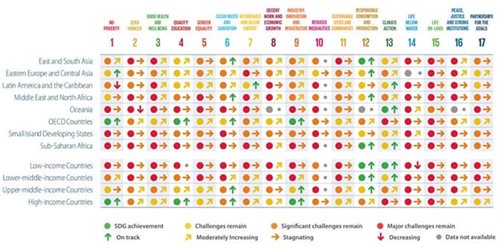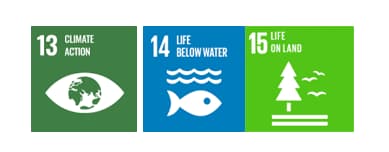вy Henning Dräger,
Sustainability Partner, BDO in Ukraine and Director, Global Sustainability
In 2015, 193 states, thousands of public and private organisations and millions of citizens started working together to create a more ecologically sound, equitable, peaceful, healthier and fairer future for the coming generations - enshrined in the 17 UN Sustainable Development Goals (SDGs). Seven years on we have made some progress, but significant challenges remain according to the UN’s own 2022 scorecard.

Source: UN The Sustainable Development Goals Report 2022
There are many often interlocking factors contributing to the slowed progress towards a more sustainable world, including our recovery from the COVID pandemic and the war in Ukraine. It is the latter that I will focus on here and look at how this war impacts a few of the SDGs:
- SGD 1 - No Poverty
- SDG 2 - Zero Hunger
- SDG 8 - Decent Work and Economic Growth
- SDG 16 - Peace, Justice and Strong Institutions
More than six million Ukrainians have fled the country since the war began on 24 February this year, often losing their homes, jobs, communities, and tragically, loved ones and friends. This is the largest human displacement crisis in the world today. According to UN High Commissioner for Refugees (UNHCR) over 7,1 million people remain displaced inside Ukraine and 15,7 million people are estimated to urgently require humanitarian assistance and protection.
It is estimated that the operations of 90% of all Ukrainian businesses (just under 1,8 million) are affected with many directly disrupted since Russia’s invasion. The economic fallout is enormous with the World Bank predicting that the Ukrainian GDP will shrink by 45 percent in 2022. Currently, the situation is relatively stable due to the active intervention of the National Bank of Ukraine with support from Western partners. However, a recent 25 percent devaluation of the Ukrainian Hryvnia, combined with rising inflation, food and energy prices is affecting the economic well-being of Ukrainians with an estimated reduction of almost 40 percent in purchasing power of an average consumer in Ukraine.
A key sector supporting economic health is agriculture providing 13 million Ukrainians with jobs and livelihoods (20 percent of the labour force) and contributing 11 percent to national GDP. Ukraine's agricultural output means it is the world’s fifth-largest exporter of wheat, fourth-largest exporter of corn, and third-largest exporter of rapeseed. A strong and stable agriculture sector in Ukraine is thus critical for global food security.
The war is impacting both the domestic supply of food and the ability of Ukraine to export its vital cereal harvest to the most food-dependent areas. The food security of more than 50 countries in North Africa, the Middle East and Asia is under threat. For example, Eritrea's wheat imports are 50% dependent on Ukrainian exports. Somalia and the Seychelles import 100% of their essential grains from Ukraine.
Over the past five years, wheat has been Egypt's essential staple, accounting for between 35% and 39% of the per-person daily energy intake. Wheat imports are around 62% and come from Ukraine and Russia. This means that the military actions in Ukraine directly impact the food security of countries with low living standards, where wheat products form a large part of the daily diet.
With some 14 percent of Ukrainian grain storage destroyed, fields, roads, rail lines, and ports mined or captured by Russian forces, the UN Food and Agriculture Organisation (UN FAO) estimates a drop of 60 percent of harvest available for export. The UN FAO also indicates the preliminary damage to the agriculture sector is between USD 4,3 billion and USD 6,4 billion due to the conflict, including damage to infrastructure such as irrigation, storage, machinery and equipment, shipping infrastructure, greenhouses, field crops, livestock and processing units.
As a result of the Russian invasion, the Ukrainian Ministry of Economy estimates that until June this year direct material damage of more than $270 billion was inflicted on Ukraine while indirect losses (GDP decline, investment cessation, the outflow of labour, additional defence and social support costs, etc) are about $600 billion.
A prolonged or ‘frozen’ conflict will add to the significant economic burden of Ukrainians and the global community. It will likely result in increased poverty levels, an unstable supply of essential foods to some of the poorest countries in the world, and the migration of potentially millions of agricultural workers unable to attend to their jobs.
The impact on education
The Ministry of Education and Science of Ukraine estimates that more than 1,500 educational institutions have been destroyed or damaged so far. While many schools and universities continue to offer remote education, evidence suggests that many Ukrainian schoolchildren and students do not have the opportunity to join a safe place of study, and experience constant disruption of Wi-Fi and lack the equipment to take advantage of online learning - especially in rural areas.
Despite these challenges, education in Ukraine goes on: remote learning, often interrupted by air-raid sirens, has been offered to millions. In June 2022, nearly 4 million children (the majority of school-aged students) showed up for online classes. Video lessons have also been broadcast on state-owned and commercial TV stations adding to the feeling that remote schooling provides a safe space and a semblance of normalcy for children affected by war.
For example, in the East Ukrainian city of Kharkiv, teachers keep organising lessons in metro stations while taking cover from the frequent shelling. Despite the perseverance and professionalism of Ukrainian educators, ensuring consistent quality of learning in such conditions remains most challenging.

All wars cause direct damage to our environment and vital ecosystems. Think about the movement of heavy tanks, use of artillery shells, discharge of oil, gas, chemicals and discarded munitions waste. Forests, wetlands, steppes, meadows, lakes, fields, parks, seas and their diverse fauna and flora are either destroyed or polluted often to the extent that they can no longer be restored.
The OECD has mapped some of the environmental and human health impacts in Ukraine directly linked to the war.
- With a steady barrage of strikes on refineries, chemical plants, energy facilities, industrial depots or pipelines, the country's air, water and soil have been polluted by toxic substances, fires and building collapses, which can cause longer-term health threats like the risk of cancer and respiratory ailments
- As a result of damage to water supply infrastructure, an estimated 1,4 million people in Ukraine currently have no access to safe water, and a further 4,6 million people have only limited access
- Military operations have also resulted in a dramatically increased amount of waste. This includes damaged or abandoned military vehicles and equipment, shell fragments, civilian vehicles, building debris or uncollected household or medical waste. Some of this waste is toxic, including shell fragments, medical waste, or building debris containing asbestos, PCB and heavy metals, and will require special handling, transport and disposal
- The Ukraine authorities estimate that due to Russia’s military activities, 900 protected natural areas of Ukraine have been affected and an estimated 1,2 million hectares, or about 30% of all protected areas of Ukraine, suffer from the effects of war
- Direct public health risks are caused by exposure to hazardous substances contained in ammunition remains which leak toxic substances into the soil and affect surface and groundwater quality. Risks come from munitions-linked heavy metals, energetic compounds, such as trinitrotoluene (TNT), hexogen (RDX), and propellants from missiles and rockets
- When the Russian military entered the Chernobyl nuclear powerplant zone, their heavy vehicles raised the level of radioactive dust for weeks with subsequent danger to surrounding communities as far as Kyiv, 100 miles south
Most pollution caused by military activities goes unreported, as monitoring systems have been disrupted or destroyed, and such damage continues to accumulate. The Ukrainian government launched several tools to document the environmental damage including a dashboard with data on the impact of the war on the environment, ‘EcoZagroza’, and the work of the State Environmental Inspection, which recorded over 250 cases of crimes against the environment and over 1,200 cases of damage to the environment from the aggression. Special units have been collecting evidence, including video and satellite images and, where possible, air and soil samples for laboratory tests. Work has also begun to develop methodologies for calculating the monetary value of the damage to the environment.
Another aspect to consider is the vast emissions caused by the use of especially oil and gas during Russia's war in Ukraine. Consider a single light tank consuming about 300 litres of fuel per 100 kilometres emitting more than 600 kilograms of CO2. A typical Russian fighter jet consumes more than 400 litres of fuel for every 100 kilometres and emits about 28,000 kilograms of CO2. In comparison, an average new car emits between 8 and 15 kilograms of CO2 per 100 kilometres.
36 Russian attacks on Ukrainian fossil fuel infrastructure were recorded in the first five weeks of the war alone, leading to prolonged fires that released soot particulates, methane and CO2 into the atmosphere, while oil infrastructure was ablaze on the Russian side too.
Finally the war has emissions implications beyond Ukraine with U.N. Secretary-General Antonio Guterres stating that it will likely have major implications for global heating targets, particularly as many countries turn to coal or imports of liquefied natural gas as alternative sources to Russian energy.
War is a disaster for global sustainable development
Russia’s invasion of Ukraine has hindered the progress of nations and businesses toward achieving global sustainability goals. Key issues the war is bringing to the fore include:
- Exacerbation of the global food security crisis, volatile food prices and a higher likelihood of reported hunger crises
- More risks to hard-won progress on the clean energy transition as investments in fossil fuels rise to ensure energy security
- A growing polarisation between democratic and autocratic views of the world making multilateral cooperation and investment to build a more sustainable world harder
It is said that our race towards achieving sustainable development has no finish line – not even with the passing of the 2030 deadline to realise all 17 SDGs. The war in Ukraine has once again shown the colossal negative impacts wars have on our environment, people, communities, business, infrastructure and institutions.
War is the most unsustainable form of human activity so may it stop soon to allow Ukraine and the world to return to the most pressing task – a joint transition to a more prosperous, peaceful, cooperative, equitable and sustainable world.